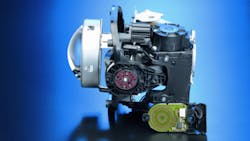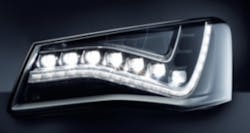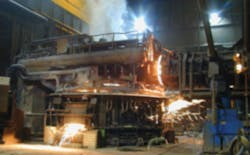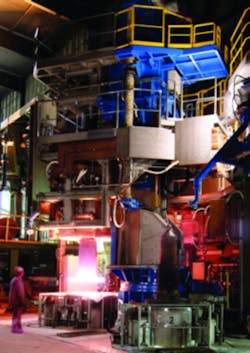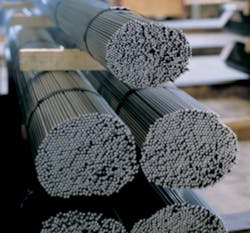New Product Design Starts With Material Selection
Headlamps for cars are no longer just light sources: today their shapes and functions are among the selling points for various automotive OEMs. To manufacture the increasingly sophisticated plastic components needed to produce lenses, color fields, and headlamp moldings, as well as the precise transmission of power in small electric motors as found in dynamic bend lighting systems, automotive suppliers need high-grade and high-performance steels.
As the complexity of lighting products increases, there is also a rising demand for high-grade special steels to be used in producing those products, and there are only a few steelmakers capable of delivering this level of quality: one of them is the Schmolz + Bickenbach Group, which works with lighting system producers like Hella KGaA Hueck / Co.
S+B produces high-grade specialty steel worldwide, in particular stainless steel long products.
In addition to high and low beams, daytime driving lights, position lights and turn-signal lights, highway lights, town lights, country lights, adverse weather, as well as static or dynamic bend lighting systems are part of the standard repertoire of modern vehicle headlamps. Developments have been moving away from the classic halogen light sources for some time, toward energy-efficient LED technology.
The custom lighting designs of individual automotive brands are expanding, too. BMWs, for example, are easy to recognize in traffic by the ring-shaped lighting elements, while Audis have light strips. "In future generations of cars, single LEDs will no longer be seen as light sources," predicted Franz-Josef Klegraf, a member of the executive board, for Hella’s Lighting Business Division. Lighting, at automotive supplier Hella. "The trend is rather to homogeneous light fields with a certain 3D effect - such as light curtains and light guides, depending on their application on the vehicle."
Hella develops and manufactures lighting and electronic components and systems for the automotive industry, and also has one of Europe’s largest supplier organizations for automotive parts, accessories, diagnosis and services.
Injection Molds with a Profile
With 27,000 employees in more than 30 countries worldwide, Hella is one of the world's largest suppliers of automotive lighting systems and electronics. At its tooling manufacturing site at Lippstadt, Germany, the company produces some of the injection molds for the plastic parts used in the various headlamps.
"We produce innovative lighting impressions, e.g. by using sophisticated surface structures on our plastic parts or optics that distribute the light as it leaves the headlamp," Klegraf explained. This microstructure slightly resembles a piece of leather and is applied by means of the injection molds to the plastic surface. Deutsche Edelstahlwerke, a Schmolz + Bickenbach Group company, is one of Hella's main suppliers of steel for molds.
Deutsche Edelstahlwerke manufactures tool steels, stainless, acid- and heat-resistant steels (RSH steels), high-grade structural and anti-friction bearing steels as well as special materials. Product dimensions range from 0.8-mm drawn wire to forged products up to 1,100 mm diameter.
Because often only one injection mold may be produced for the headlamp components of a certain model, the requirements are very high for the steels chosen for that mold. They should not only be corrosion-resistant and hard in order to guarantee the long tool life, but also must have a surface that is easy to polish. "For extremely demanding applications, we usually recommend our Thermodur 2343 Superclean material for Hella," explained Hans-Georg Maschetzke, Deutsche Edelstahlwerke’s sales manager for machining and service. "Due to its composition and our unique production and machining processes, Thermodur 2343 Superclean is optimally suited to the automotive supplier's individual requirements profile.
Steel produced at Deutsche Edelstahlwerke starts as scrap, melted with other high-grade secondary raw materials in a 130 t electric arc furnace. After adding the alloys necessary for the particular grade of steel (e.g., chromium, nickel, molybdenum, vanadium, wolfram or cobalt), the liquid steel is emptied into an existing ladle for further treatment.
Then, this ladle is used for the secondary steelmaking stage, in which undesirable gas and oxygen contents are extracted from the molten steel and microalloying is done to set the specific metallurgical composition needed in the finished product.
"Even the smallest of impurities in the steel can have an impact on the plastic mold, and thus also on the parts and the headlamp's light pattern," Maschetzke explained. "This is why our Thermodur 2343 Superclean material is remelted a second time and virtually filtered” — a process known as ESR / VAR (for electro-slag remelting and vacuum-arc remelting) — “to remove even the smallest segregations and impurities." The ensuing diffusion annealing processes, the forging to the final dimensions, as well as extensive annealing treatments produce steel blocks with a consistently homogeneous structure that serve as the basis for mold production at Hella.
The headlamp manufacturer and one of its suppliers then carry out most of the machining steps on the mold and return the workpiece to Deutsche Edelstahlwerke for vacuum heat treatment. "Heat treatment is one of the most decisive work steps because this is where the mold is given the hardness it needs for later use," Maschetzke emphasized.
In this process, the form is heated and allowed to cool at certain intervals to change the steel's internal structure to achieve the requirements of durability for injection molding operations.
The final step of production for the mold itself is undertaken by Hella, which will polish and machine the surface of the mold to the specific dimensional and surface requirements. For example, to achieve design effects, parts of the form are processed by means of an etching process," Klegraf explained. After several test runs and releases, the injection mold is finally ready for use at one of Hella's four sites for headlamp production in Europe, Mexico, and China.
In addition to the Thermodur 2343 Superclean material, Deutsche Edelstahlwerke recommends other materials for plastic injection molding applications. Formadur 2083 Superclean has a higher chromium content that is even more resistant to corrosion and wear. The latest development is PH X Superclean, which does not require the usual heat treatment and still manages to meet the highest corrosion requirements.
Formadur 2738 and new development Formadur 320 are steels with low hardness. They make production of simpler plastic molds without elaborate surface designs, or which have fewer demands on service life, much more cost effective. "In Deutsche Edelstahlwerke we have a partner who supports us by providing high-grade steels and qualified process know-how in Germany and in our distribution countries - and they have done so for over 20 years," reported Franz-Josef Klegraf.
Dynamic Bend Lighting, Precisely Directed
In addition to light-emitting elements, modern Xenon or LED headlamps will also contain several motors that adapt the light cone to the actual circumstances. When the car is started, for example, sensors measure the height of the beam and adapt its direction, depending on the vehicle load so as not to “dazzle” drivers in the oncoming traffic.
Even more complex is the control of the dynamic bend lighting system. Compared to static bend lighting that illuminates the areas along the side of the road at a fixed angle, dynamic bend lighting systems flexibly adapt the diffusion of the light cone to the vehicle's environment. To do so, sensors constantly measure speed and steering angle of the vehicle. The latest systems also use data provided by an onboard camera or GPS data to predict driving situations.
An electric pulse to the bend lighting system’s motor transmits the optimal degree of illumination derived from this data, and the beam is adjusted accordingly. In setting the turn angle, both rapid response and high accuracy are important. In this case, motor shafts are needed that are precise and translate the incoming pulse in an exact movement.
A recommended material for this is ETG 25, a special high-grade bright steel produced by Steeltec AG, another the Schmolz + Bickenbach Group companies, and supplied to various automotive suppliers as the starting material for drive shafts. "Precision parts for these mechanisms must meet the strictest requirements safely and reliably, year after year," noted Guido Olschewski, who heads the Product Development division at Steeltec AG.
ETG 25 is a material that unites apparent opposites. It is both easy to machine as well as very strong in application - without necessitating further processing steps, such as heat treatment. "Specifically in the automotive sector, our steel is thus increasingly seen as an alternative to conventional materials and is being used for applications that make high demands on resilience and accuracy," Olschewski stressed.
Headlamps for the automotive industry are becoming more and more complex in design and functionality. Lighting systems today now adapt automatically and flexibly to a wide range of road and weather conditions and process a vast assortment of data. Increasingly, the design of headlamps and rear lights is also a point for distinction that automakers use as a selling point, and new shapes and designs such as light curtains and light-emitting elements are opening up numerous possibilities.
Headlamps for cars are no longer just light sources: today their shapes and functions are among the selling points for various automotive OEMs. To manufacture the increasingly sophisticated plastic components needed to produce lenses, color fields, and headlamp moldings, as well as the precise transmission of power in small electric motors as found in dynamic bend lighting systems, automotive suppliers need high-grade and high-performance steels.
As the complexity of lighting products increases, there is also a rising demand for high-grade special steels to be used in producing those products, and there are only a few steelmakers capable of delivering this level of quality: one of them is the Schmolz + Bickenbach Group, which works with lighting system producers like Hella KGaA Hueck / Co.
S+B produces high-grade specialty steel worldwide, in particular stainless steel long products.
In addition to high and low beams, daytime driving lights, position lights and turn-signal lights, highway lights, town lights, country lights, adverse weather, as well as static or dynamic bend lighting systems are part of the standard repertoire of modern vehicle headlamps. Developments have been moving away from the classic halogen light sources for some time, toward energy-efficient LED technology.
The custom lighting designs of individual automotive brands are expanding, too. BMWs, for example, are easy to recognize in traffic by the ring-shaped lighting elements, while Audis have light strips. "In future generations of cars, single LEDs will no longer be seen as light sources," predicted Franz-Josef Klegraf, a member of the executive board, for Hella’s Lighting Business Division. Lighting, at automotive supplier Hella. "The trend is rather to homogeneous light fields with a certain 3D effect - such as light curtains and light guides, depending on their application on the vehicle."
Hella develops and manufactures lighting and electronic components and systems for the automotive industry, and also has one of Europe’s largest supplier organizations for automotive parts, accessories, diagnosis and services.
Injection Molds with a Profile
With 27,000 employees in more than 30 countries worldwide, Hella is one of the world's largest suppliers of automotive lighting systems and electronics. At its tooling manufacturing site at Lippstadt, Germany, the company produces some of the injection molds for the plastic parts used in the various headlamps.
"We produce innovative lighting impressions, e.g. by using sophisticated surface structures on our plastic parts or optics that distribute the light as it leaves the headlamp," Klegraf explained. This microstructure slightly resembles a piece of leather and is applied by means of the injection molds to the plastic surface. Deutsche Edelstahlwerke, a Schmolz + Bickenbach Group company, is one of Hella's main suppliers of steel for molds.
Deutsche Edelstahlwerke manufactures tool steels, stainless, acid- and heat-resistant steels (RSH steels), high-grade structural and anti-friction bearing steels as well as special materials. Product dimensions range from 0.8-mm drawn wire to forged products up to 1,100 mm diameter.
Because often only one injection mold may be produced for the headlamp components of a certain model, the requirements are very high for the steels chosen for that mold. They should not only be corrosion-resistant and hard in order to guarantee the long tool life, but also must have a surface that is easy to polish. "For extremely demanding applications, we usually recommend our Thermodur 2343 Superclean material for Hella," explained Hans-Georg Maschetzke, Deutsche Edelstahlwerke’s sales manager for machining and service. "Due to its composition and our unique production and machining processes, Thermodur 2343 Superclean is optimally suited to the automotive supplier's individual requirements profile.
Steel produced at Deutsche Edelstahlwerke starts as scrap, melted with other high-grade secondary raw materials in a 130 t electric arc furnace. After adding the alloys necessary for the particular grade of steel (e.g., chromium, nickel, molybdenum, vanadium, wolfram or cobalt), the liquid steel is emptied into an existing ladle for further treatment.
Then, this ladle is used for the secondary steelmaking stage, in which undesirable gas and oxygen contents are extracted from the molten steel and microalloying is done to set the specific metallurgical composition needed in the finished product.
"Even the smallest of impurities in the steel can have an impact on the plastic mold, and thus also on the parts and the headlamp's light pattern," Maschetzke explained. "This is why our Thermodur 2343 Superclean material is remelted a second time and virtually filtered” — a process known as ESR / VAR (for electro-slag remelting and vacuum-arc remelting) — “to remove even the smallest segregations and impurities." The ensuing diffusion annealing processes, the forging to the final dimensions, as well as extensive annealing treatments produce steel blocks with a consistently homogeneous structure that serve as the basis for mold production at Hella.
The headlamp manufacturer and one of its suppliers then carry out most of the machining steps on the mold and return the workpiece to Deutsche Edelstahlwerke for vacuum heat treatment. "Heat treatment is one of the most decisive work steps because this is where the mold is given the hardness it needs for later use," Maschetzke emphasized.
In this process, the form is heated and allowed to cool at certain intervals to change the steel's internal structure to achieve the requirements of durability for injection molding operations.
The final step of production for the mold itself is undertaken by Hella, which will polish and machine the surface of the mold to the specific dimensional and surface requirements. For example, to achieve design effects, parts of the form are processed by means of an etching process," Klegraf explained. After several test runs and releases, the injection mold is finally ready for use at one of Hella's four sites for headlamp production in Europe, Mexico, and China.
In addition to the Thermodur 2343 Superclean material, Deutsche Edelstahlwerke recommends other materials for plastic injection molding applications. Formadur 2083 Superclean has a higher chromium content that is even more resistant to corrosion and wear. The latest development is PH X Superclean, which does not require the usual heat treatment and still manages to meet the highest corrosion requirements.
Formadur 2738 and new development Formadur 320 are steels with low hardness. They make production of simpler plastic molds without elaborate surface designs, or which have fewer demands on service life, much more cost effective. "In Deutsche Edelstahlwerke we have a partner who supports us by providing high-grade steels and qualified process know-how in Germany and in our distribution countries - and they have done so for over 20 years," reported Franz-Josef Klegraf.
Dynamic Bend Lighting, Precisely Directed
In addition to light-emitting elements, modern Xenon or LED headlamps will also contain several motors that adapt the light cone to the actual circumstances. When the car is started, for example, sensors measure the height of the beam and adapt its direction, depending on the vehicle load so as not to “dazzle” drivers in the oncoming traffic.
Even more complex is the control of the dynamic bend lighting system. Compared to static bend lighting that illuminates the areas along the side of the road at a fixed angle, dynamic bend lighting systems flexibly adapt the diffusion of the light cone to the vehicle's environment. To do so, sensors constantly measure speed and steering angle of the vehicle. The latest systems also use data provided by an onboard camera or GPS data to predict driving situations.
An electric pulse to the bend lighting system’s motor transmits the optimal degree of illumination derived from this data, and the beam is adjusted accordingly. In setting the turn angle, both rapid response and high accuracy are important. In this case, motor shafts are needed that are precise and translate the incoming pulse in an exact movement.
A recommended material for this is ETG 25, a special high-grade bright steel produced by Steeltec AG, another the Schmolz + Bickenbach Group companies, and supplied to various automotive suppliers as the starting material for drive shafts. "Precision parts for these mechanisms must meet the strictest requirements safely and reliably, year after year," noted Guido Olschewski, who heads the Product Development division at Steeltec AG.
ETG 25 is a material that unites apparent opposites. It is both easy to machine as well as very strong in application - without necessitating further processing steps, such as heat treatment. "Specifically in the automotive sector, our steel is thus increasingly seen as an alternative to conventional materials and is being used for applications that make high demands on resilience and accuracy," Olschewski stressed.
Headlamps for the automotive industry are becoming more and more complex in design and functionality. Lighting systems today now adapt automatically and flexibly to a wide range of road and weather conditions and process a vast assortment of data. Increasingly, the design of headlamps and rear lights is also a point for distinction that automakers use as a selling point, and new shapes and designs such as light curtains and light-emitting elements are opening up numerous possibilities.
